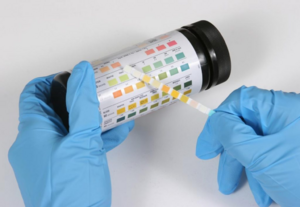Urinalysis: Difference between revisions
No edit summary |
No edit summary |
||
| Line 42: | Line 42: | ||
== Haemoglobin == | == Haemoglobin == | ||
The urine dipstick can be helpful in diagnosing microscopic [[haematuria]]. This can be useful in the evaluation of urinary tract pathologies like stones and cancer. Urinary tract infection can also cause microhaematuria. In case of gross [[haematuria]], the urinary dipstick result has no clinical utility. | The urine dipstick can be helpful in diagnosing microscopic [[haematuria]]. This can be useful in the evaluation of urinary tract pathologies like stones and cancer. Urinary tract infection can also cause microhaematuria. In case of gross [[haematuria]], the urinary dipstick result has no clinical utility. | ||
== References == | |||
[[Category:Laboratory Medicine]] | [[Category:Laboratory Medicine]] | ||
Revision as of 20:14, 24 May 2024
A urine dipstick test, sometimes abbreviated as urinary stick or u-stix is a point-of-care test which is used to analyse certain parametres of the urine. It's quick and cheap, and can be read off manually or by automatic machines. They're used in the diagnosis and follow-up of many disorders, like urinary tract infection, diabetes mellitus, and chronic kidney disease. A normal dipstick evaluates the following parametres in the urine:
- Leukocytes
- Nitrate
- Protein
- Glucose
- Ketones
- Haemoglobin
The test is semiquantitative. This means that it cannot exactly tell the amount of the above compounds are present in the sample, but the degree of colour changes corresponds roughly to the amount.
Urinary sample collection
Proper sample collection is essential to maintain as high sensitivity and specificity as possible. A sterile container for urine collection is obligatory to prevent contamination. The patient should not provide a sample if they've peed in the previous 4 hours, as in these cases the urine is "too fresh" to show signs of bacterial infection. Morning urine is usually best. The male should withdraw the foreskin and the female should spread the labia when making the sample, to prevent contamination. The initial urine should be discarded; mid-stream urine should be used.
Procedure

The patient provides a urinary sample. A single-use paper strip is dipped into the urine. The strip contains multiple squares covered with different reagents, each of which change colour when coming into contact with certain compounds in the urine. The degree of colour change is compared to a standard which is usually printed on the bottle.
Leukocytes
The presence of leukocytes in the urine, leukocyturia, is a sign of infection or bacterial colonisation in the urinary tract, or contamination from the vagina or penis.
If the urine sample was collected optimally, the sensitivity for upper or lower urinary tract infection in case of leukocyturia is approximately 80%, but it can also be positive in case of other pathologies in the urinary tract, like tumours or kidney stones.
Nitrite
In a healthy person, the urine contains no nitrite. Many bacteria, especially gram negatives, reduce nitrate in the urine to nitrite. Because not all bacteria causing urinary tract infection reduce nitrate, the test is not particularly sensitive (approx 50%), but assuming optimal sample collection, it's quite specific (90%).
Nitrate is found in the urine usually from dietary intake of vegetables. Lack of vegetables in the diet reduces the amount of nitrate in the urine, and as a result, the amount of nitrite and the sensitivity of the test as well.
The urine sample must be taken at least 4 hours after the previous bladder emptying, as bacteria in the bladder require a few hours to reduce nitrate to nitrite.
Protein
The urine dipstick actually measures albumin and not all protein. A typical dipstick can detect albumin levels above 300 mg/L, but levels between 30 - 300 mg/L are also clinically significant, defined as microalbuminuria. As such, a direct laboratory examination of the urine to exactly measure protein and albumin contents, usually as part of the albumin-creatinine-ratio (ACR), is more clinically useful than the urine dipstick test for protein.
A positive result shows albuminuria, which can be seen in many kidney disorders, but also to some degree in healthy people and during fever.
Glucose
The glomeruli usually reabsorb virtually all filtrated glucose, but if the serum glucose level rises above 10 mmol/L, the reabsorption cannot keep up, causing glucosuria. This is present in people with diabetes mellitus.
Ketones
Ketones are present in the urine when they're present in the blood, which occurs during ketoacidosis and starvation. Diagnosis of these conditions rarely depend on the urine analysis, as we usually diagnose ketoacidosis based on serum glucose levels anyway.
Haemoglobin
The urine dipstick can be helpful in diagnosing microscopic haematuria. This can be useful in the evaluation of urinary tract pathologies like stones and cancer. Urinary tract infection can also cause microhaematuria. In case of gross haematuria, the urinary dipstick result has no clinical utility.
